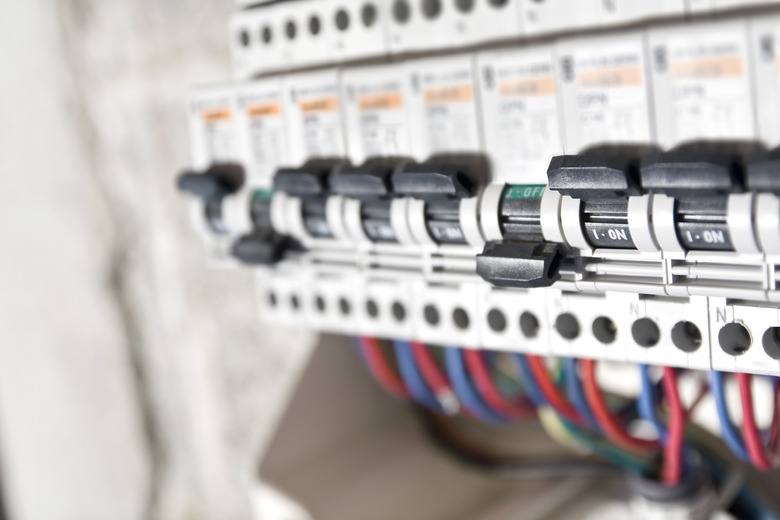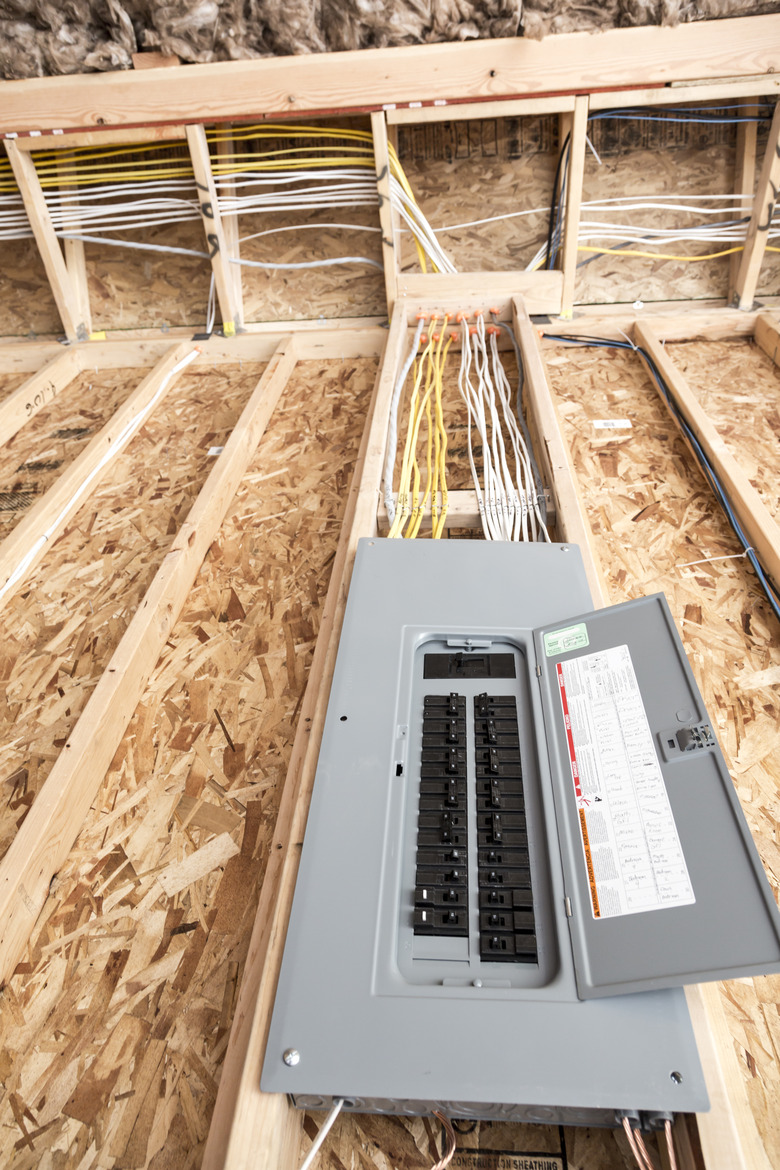Whole-House Surge Protector Installation: What It Costs And How It's Done
We may receive a commission on purchases made from links.
Although most homeowners are familiar with a surge protector that they plug into the wall, whole-house surge protectors — ones that are wired into your home's electrical system — prevent damage from electrical power surges to all sensitive electronic equipment in the house (not just the ones plugged into the surge protector). Power surges can originate from both outside and inside the home, and the level of havoc they can wreak can be devastating, potentially leading to thousands of dollars in damage to electronic devices and systems.
A whole-house surge protector — technically called a surge protective device, or SPD — can help protect those electronic components and give you peace of mind. These units sense the increase in power and direct it to the home's grounding system. The grounding system consists of rods buried in the ground outside of the house that are connected by wire to the main electrical panel box, although in some homes the box is connected to a cold water pipe where it enters the home. In both cases, the electrical current passes harmlessly to the ground.
In addition to shielding obvious items, like computers and sophisticated video and audio equipment, a whole-house surge protector prevents damage to anything with a circuit board. Some household items that contain circuit boards include appliances like refrigerators, washing machines, dishwashers and even LED light bulbs.
There are two different methods of installing whole-house surge protection for the increasing number of sensitive electronics in our homes — and both are best tackled by a professional electrician. The protection is important enough that many building codes, including the latest version of the National Electric Code, require whole-house surge protection in all new construction, as well as for extensive remodeling projects.
How Power Surges Damage Electronics in the Home
How Power Surges Damage Electronics in the Home
Electronic components are designed to operate with a constant level of electricity. When there are fluctuations in the levels, it can damage those components. A lightning strike on power lines or a utility company transformer can send a huge amount of damaging electrical current through the lines and into your home's electrical system. Power lines pulled down by fallen trees during a hurricane or other violent storm can also cause a spike in power.
The items inside your home can also cause electrical surges. It's estimated that 60 to 80 percent of power spikes are caused by items like HVAC systems, window air conditioners, refrigerators and the like. When the motor of a large appliances turns on or off, it requires increased power which disrupts the flow of electricity in the rest of the house. Though they are not as dramatic as a lightning strike, and most of them go unnoticed, but the continual increases in electrical current take their toll on electronic circuit boards, shortening their life and affecting their efficiency.
The Two Types of Whole-House Surge Protectors — and How They're Installed
The Two Types of Whole-House Surge Protectors — and How They're Installed
Usually, a whole-house surge protector is labelled either a type 1 or type 2 device, but there are some that can be labeled as both. SPDs are permanent installations that are hardwired into the home's electrical system. They provide surge suppression from outside the house as well as inside.
A type 1 SPD is installed before it enters the home. It's called a line-side installation, and it means the device sits between the utility service lines and your home's electrical service panel. These systems are usually designed to prevent very high surges from entering the house, but they may let smaller surges through. Installation is always a job for a licensed electrician. The utility company will be directly involved because it will need to shut off power to the home during installation.
A type 2 SPD is installed on the load side of the system, or after the power enters your electrical service panel. These units are attached to a circuit breaker located within the breaker panel. Installation will vary from product to product, but in most cases, the SPD is attached to the wall next to or beneath the panel box. Wires from the SPD run into the breaker box through knockouts in the side or bottom of the box.
The whole-house surge protector has four wires: a neutral, a ground and two hot wires. The neutral and ground wires are attached to the respective bus bars, which are located beneath a protective cover on the panel. This ensures that the surplus electrical current created during a surge is diverted to the house's grounding system. The hot wires are connected to a two-pole circuit breaker that is placed near the top of the panel box.
The strip surge protectors you plug into a household outlet to protect computers, TVs and gaming consoles are called point-of-use devices, or type 3 surge protectors. In many cases, they provide adequate protection to the items plugged into them, but they do not provide whole-house protection. Don't confuse strip surge protectors with standard power strips that offer no protection against voltage spikes.
Surge Protector Building Codes
Surge Protector Building Codes
The 2020 National Electric Code (NEC) requires that either a type 1 or type 2 whole-house surge protector be installed in all new construction of single-family, two-family and multifamily homes. Renovation projects that include updating or altering the electrical service panel must also include a whole-house SPD.
The NEC establishes safety standards for the installation and use of electrical devices, such as ground-fault circuit-interrupters (GFCI) and arc-fault circuit-interrupters (AFCI). The whole-house surge protector requirement is designed to protect safety equipment that relies on electronics to operate, such as GFCIs and hardwired smoke alarms and carbon monoxide detectors.
The NEC is a model building code provided as a reference for the building codes of local jurisdictions. Not all communities incorporate new code changes into their requirements at the same rate, and any NEC recommendation may or may not be included in the code where you live. However, if you are having new construction or extensive remodeling work done on an old house, it pays to have a whole-house surge protector installed at that time. Always check with the local code authority for specific requirements.
Choosing Whole-House Surge Protectors
Choosing Whole-House Surge Protectors
There are a few things for which to look when considering an SPD. The first is to make sure the product is listed as following the standards of UL 1449 (the latest edition). UL is an independent organization that certifies products that meet a set of standards.
You will also want to know how much power the unit can handle. This is called the voltage protection rating, and it is expressed in kiloamps, or kA. The lowest rating for an SPD is 10kA, but most offer much higher protection, usually above 30kA, with some offering over 100kA of protection. The average lightning strike discharge is between 30kA and 40kA, and about 10 percent of strikes exceed 100kA.
The maximum continuous operating voltage determines the amount of voltage the unit can handle before it begins to divert the power — a process called clamping. This prevents the problem of having the unit trip every time the incoming power goes a little bit — say, one or two volts — above the normal incoming power, which is usually 120 volts. Most units are set to begin clamping when the spike is 15 to 20 percent above the norm.
The National Electrical Manufacturers Association provides ratings for the enclosures of whole-house surge protectors. The ratings run from type 1 through type 4X for residential use. Don't confuse these enclosure ratings with the SPD type ratings. Type 1 enclosures are for indoor use and protect against touching the components in the SPD. Type 4X can be used inside or outside and protect against wind, rain and snow.
Whole-House Surge Protector Costs
Whole-House Surge Protector Costs
Expect to pay between $100 and $300 for a residential whole-house protector plus installation costs for one or two hours of work. It is best to discuss your needs with an electrician to get the right unit for your home. Factors that can affect the cost include the amount of power a unit can handle, the type of enclosure and any extras, such as indicator lights that let you know the unit is working or not working.
An SPD diverts excess power to the grounding system of the home, so it may be necessary to upgrade the grounding system if it does not meet current standards. It is also worth considering replacement costs. Most SPDs have consumable components, meaning during a heavy power surge, your electronics may be saved, but the surge could knock out the SPD's ability to function. That means an electrician will have to install a new unit to ensure surge protection.
Some units have consumer-friendly replacement modules. Indicator lights let you know the status of the system, and when it is time to replace a module, you cut the power to the unit and exchange the spent part for a new one.

